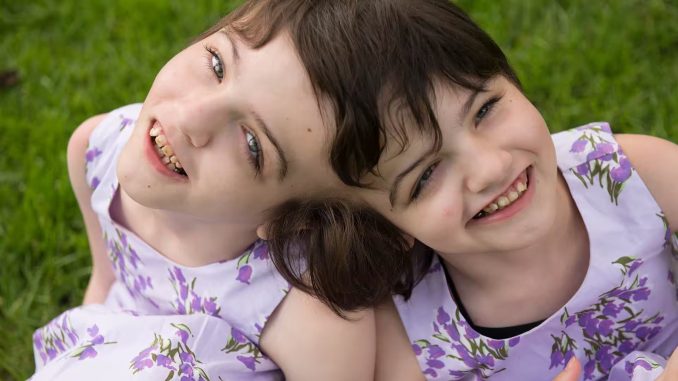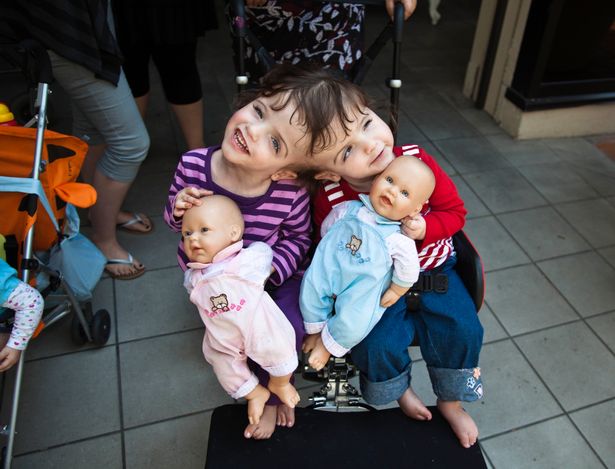
Krista and Tatiana Hogan, conjoined twins from British Columbia, Canada, gained much more prominence after the CBC documentary, “Inseparable: Ten Years Joined At The Head,” covered their story in 2017. The cameras captured a year in their life around their 10th birthday and how their family, at the time consisting of parents, grandparents, three siblings, and a dog named Yuna, helped them live a fulfilling life. Here’s what makes the twins distinctive, and how they handled the media spotlight.
Tatiana and Krista are unique
The conjoined twins, or Siamese twins, are joined in utero, and the phenomenon is still not fully explained. The Canadian girls were a rarity through birth alone; about half of the twins with this birth disorder are stillborn, and roughly a third of those who survive die within 24 hours. Moreover, Tatiana and Crista are craniopagus twins, meaning that they are joined at the head, which only happens to one of 2.5 million twins. However, their brain structure makes them the only such twins in Canada and perhaps the world. They can do things that still confuse neurologists, including reading each other’s thoughts, seeing out of each other’s eyes, and sharing some senses. However, they’ve had several medical issues and underwent physical therapy in the show. Besides a reduced quality of life, they will likely have a shorter lifespan.
Other networks covered their story before CBC
Most people don’t realize that Tatiana and Krista agreed to share their unique experience with the world long before the CBC documentary. They were featured in the Vancouver Sun segment in 2013, and The New York Sun interviewed them a year earlier. ABC media network was one of the first media networks to bring light to their unique lifestyle and medical mystery in June 2010.
All investigations agree on one thing; the sisters have different personalities and are full of life seemingly despite unsurmountable odds of surviving childhood and living a normal life.
Besides different characters, they had distinct body weights from birth on 25 October 2006. Krista was always a bit bigger, quieter, quirkier, and loved telling jokes, while Tatiana was hyperactive, chatty, loud and outgoing. Kristi’s funny side came out at the documentary’s beginning since she jokingly said that she doesn’t like being stuck to her sister because ‘she’s annoying.’ In contrast, their mom called Tatiana ‘a little bully.’ She spoke from experience; the girls have three siblings, a younger sister Shaylee, an older sister Rosa, and an older brother Cristopher “Toad” Hogan.

They are a medical miracle
Doctors who conducted a CT scan of their heads when they were a year and a half old have concluded that they could never separate them because of how their heads are fused. They learned that the girls didn’t have two joined skulls; instead, they had one skull or cranium with four brain hemispheres inside. With that information in mind, trying a separation operation would put them at risk of infection, severe injury, and quite possibly death.
However, the scan also showed that the twins’ connection is unique; they have a bridge that connects their thalami, a gray matter shaped like an egg that controls sensory input and the brain’s motor functions. Because theirs are linked, the sensory input and blood go back and forth, like they are using a switchboard. Therefore, the twins share the senses of taste and touch, and Krista can see out of one of Tatiana’s eyes while Tatiana can see out of both of Krista’s.
Moreover, they can control each other’s limbs besides self-control; Krista can move three legs and an arm, while Tatiana can control a leg and three arms. Finally, they learned that Tatiana’s heart was working harder and supplying some of its blood to Krista’s brain, which made Krista’s blood pressure higher. Doctors plan to solve this by jumpstarting Krista’s heart to adjust its rhythm, and make it pick up the pace. Yet, their most amazing ability, at least to outsiders, is knowing each other’s thoughts without speaking, which they call ‘talking in their heads.’
Krista and Tatiana don’t let the medical issues stop them
Although it’s uncertain if being conjoined had an effect, the twins have epilepsy and type 1 diabetes. They are on a strict medication regimen, most undergo blood tests to manage their sugar, and require daily insulin injections, and thus often travel to the British Columbia Children’s Hospital in Vancouver. That was a hit for their finances because the girls live in Vernon, British Columbia, with mom Felicia Simms, dad Brendan Hogan, grandparents Louise ad Doug McKay, and some aunts and uncles.
Despite all the physical problems, the twins travel to school, ride a customized bicycle, and swim. During winter, the twins go down hills on toboggans, and have tried cross-country skiing.
Tatiana and Krista Hogan are conjoined twins of the brain and can see through each other’s eyes and read each other’s mind.
Posted by North Links updates on Monday, November 30, 2020
They are pursuing education
Krista and Tatiana had a slightly delayed education path due to their unique situation. They delayed starting kindergarten at Okanagan Landing Elementary to fly to Manhattan and appear on Anderson Cooper’s daytime talk show, “Anderson.” Their mother said that most children around their age were curious, and some befriended them. However, a few parents were uncomfortable seeing them, and forbade their children to play with them, which Felicia openly criticized, prompting her to ensure that her children never shun anyone for being different.
Although their unique congenital disorder slowed their academic progress, the documentary showed that they started attending regular school. The twins spent a few hours per day in Grade 6 as of September 2017, learning to write, read, and do basic arithmetic.
Twins live their lives away from the public
Sadly, the CBC documentary was the last public update from the twins, and that was seemingly intentional. Chuck Harris, a Hollywood agent, is the only reason they became well-known for several years. He signed the twins for all the media appearances in the late 2000s and early 2010s because he ‘wanted to get a reality show for them so badly, to make big money. For them, anything over $1,000 is big money.’
He explained that the family had fourteen members in one household in 2011. Their mom, known for being protective, agreed to Chuck’s proposal, and told him, ‘We can do interviews and documentaries. Just get the word out. I want people to understand that’s just what they are—they’re just little girls.’
LIVE: Born conjoined at the head 10 years ago, meet Krista and Tatiana Hogan in a new documentary from @JudithPyke .https://t.co/v5H4AHmyop pic.twitter.com/bHtVNSZYNB
— CBC British Columbia (@cbcnewsbc) November 4, 2017
Chuck also represented George and Lori Schappel, the oldest living conjoined twins in the world as of 2022, according to the Guinness World Records notes. He also wanted to find their mom a job, giving parenting lectures and speculated that she could earn CAD$5,000 to $15,000 an hour, talking about ‘how she’s raising the girls, not hiding them, and doesn’t see their condition as a handicap.’
Krista and Tatiana contributed to science
Viewers saw the conjoined twins’ daily life, including all their struggles, which was captivating. However, their media appearances had a real impact on science and medicine. Their mother always knew that her daughters might not reach the average lifespan; the doctors told her that they had a 20% chance of survival at birth and that the danger was not over in the first 24 hours. Upon turning 10 in the documentary, their mother explained, ‘For them to actually be here for 10 years is just a blessing. It just felt so good to see them get to this milestone.’
However, the documentary also showed how amazed their pediatric neurologist, Dr. Juliette Hukin was, and how much she learned from their unique brainstem connection. Neurosurgeons and other medical professionals they met had a similar reaction.
Ultimately, their mother never wanted fame or preferential treatment for them. At the end of the episode, she said, ‘They’re just little people living their lives like the rest of us. That’s how we see them, and that’s how their siblings see them.’
Moreover, Tatiana and Krista have inspired clinical research. Their case has been cited in many clinical studies, for example, “Craniopagus: Overview and the Implications of Sharing a Brain” by Jordan Squair at the University of British Columbia’s Undergraduate Journal of Psychology in 2012.
Leave a Reply